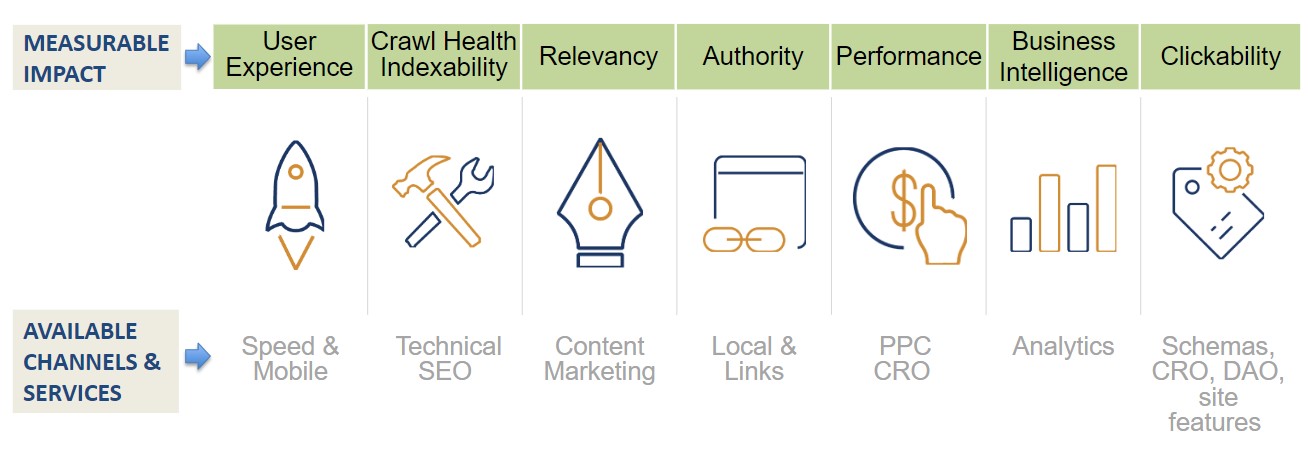Looking to stay ahead the digital marketing curve?
Discover the planning must-haves for search, digital, voice, and omnichannel strategies.
I had the pleasure of moderating a sponsored Search Engine Journal webinar presented by Benu Aggarwal, President and Founder of Milestone Inc., and Bill Hunt, President, Back Azimuth Consulting.
They discussed the 12 steps you can take in order to create a robust digital strategy.
Here’s a recap of the webinar presentation.
Creating a Robust, Holistic Digital Strategy
In the last 20 years, search has evolved significantly.
Search is no longer about simple keywords, but conversations across different devices.
The algorithm updates rolled out by Google used to be about fighting spam. Now they’re aimed at enhancing user experience.
With all these changes, it is important to rethink how we’re approaching search as it is becoming more conversational.
We’ve been trained to type abbreviated queries such as “restaurants”, “pizza” or “Thai food” near me.
As people start to move into voice, they’re back to asking questions. SEO professionals need to be able to understand the nuance.
This is exactly what Google’s BERT does which is to help “better understand the nuances and context of words in searches and better match those queries with more relevant results.”
Marketers need to take a step back and plan on taking on all of your content and assets with the goal of not only owning the shelf space at Google’s SERPs but also through other channels.
To come up with a robust digital strategy, you first need to answer this question:
What business problems are we solving?
- Drive awareness, more foot traffic?
- Start a new business or do a rebrand?
- Get direct conversions?
- Drive engagement?
- Etc.
After understanding what problems need to be solved, then you can come up with the right channels, strategies, and tactics to pursue.
12 Steps to Create Robust Digital Strategy This Year
Step 1: Find Searcher Intent
Do you have the assets that can meet your customer needs? If not, start creating them.
With the growth of voice search, it’s much more important to focus on topical content rather than specific keyword themes.
Focus on what your audience is looking for and build natural content around those themes.
You can go to different tools and find out what people looking for or you can simply talk to people who are servicing your customers.
Analyze the types of questions that your clients and visitors ask every day about your store, location, hotel, and destination. These questions capture voice and natural search queries.
Build pages and content around those questions as they are highly relevant to your user. Make sure to provide answers that are informative and help solve your customer’s problem.
Keywords are still important, but they should not be the sole focus of your content, your user should be.
Step 2: Align Digital Assets with Content Strategy
Next, we need to look at our entire set of assets through the lens of the customer.
Our assets must align with what type of content customers actually need.
Step 3: Focus on Entity Search
Google is using entities to make decisions and it is important to leverage them.
For instance, schemas on bank websites drive online product sales. A bank is not only a financial institution. It has various financial products and each of them have different entities.
As we’re accumulating this information, just simply using schema and trying to align these pieces can result in a 20-30% increase in your organic traffic.
Step 4: Get Ready for Voice Search
Since questions capture natural search queries, you can start gathering your frequently asked questions (FAQs), create content to answer them, and then publish across all channels (such as chatbots).
This will be helpful as we prepare for more voice search queries in the future.
Step 5: Leverage Critical FAQ Data Across Multiple Platforms
Marketers need to leverage technology integration and automation to scale marketing tasks while providing that real customer experience.
There are solutions that address the changing landscape of search where more and more consumers are searching using personal assistant devices.
For example, Milestone offers a platform for businesses to manage all their FAQs for voice search. The queries can be sourced from Google, Bing, Yelp, and SEMrush.
Milestone’s platform provides a convenient dashboard to create queries and manage the answers. It allows for collaboration.
It can also be used to feed the FAQs to your website and also to chatbots and to Milestone’s Voice Actions Platform.
Once you’ve nailed down all five steps above, then it’s time to start looking into local.
Optimizing for local search and enhancing your GMB listings could boost your results.
Step 6: Have Accurate & Enhanced Information Across All Channels
We already know that accurate NAP (Name, Address, Phone Number) data is critical for local businesses. That is still true in today.
We can take it up a notch and use a platform that allows us to create a central hub where we have all our business information stored and then that same set of info can be easily published as well to other digital channels.
Consistent data and enhanced listings can lead to amazing local performance.
Step 7: Optimize for Traffic & Get People the Right Answer
Adding a touch of personalization is also an exceptional way to deliver answers to FAQs, especially for users who are using a voice device.
It’s all about being that right answer.
Step 8: Saturate SERPS & Universal Results
You want to take all the steps above to ensure your content matches the search intent across all formats in order to dominate Google’s SERPs.
The key to success is to truly understand and align with the users’ needs across all devices.
Step 9: Aim for the Best User Experience
Most SEOs only think SEO but you need to blend all channels to really engage with the user.
Your website should demonstrate:
- Authority
- Sound technical SEO
- Relevancy
- Speed
- Clickability
After addressing the above, you can further enhance the experience through newly optimized assets:
- Make callouts to relevant service information.
- Include galleries and packages.
- Include schemas to all technical information related to venues, facts, etc.
- Include videos: use content from YouTube Channel and identify content opportunities.
Step 10: The Right Answers Can Be Monetized
The right answers you provided can be monetized.
Monetize your questions with links to ecommerce events, etc.
Step 11: Holistic Strategy Across All Channels
We need to create a holistic strategy to align your business objectives to the nature of the SERPs.
You need to determine the impact you’re going to measure before thinking about the channel.

Step 12: Convert Knowledge Into Wisdom
When you leverage an internal framework that aligns business objectives with needs and strategy, you get amazing results.
Q&A
Here are just some of the attendee questions answered by Bill Hunt.
Q: If you can name ONE site-related aspect (such as on-page SEO but don’t tell me content because it is too obvious and general) that a business needs to focus on, what would that be? Speed? Meta data? UX/UI for conversion?
Bill Hunt (BH): Snippet optimization after ensuring that you’re well indexed. Nothing else matters unless these are accounted for.
Q: How would you help a franchise optimize their online listing of my business without a separate vanity site?
BH: Focus on the location by ensuring all of your NAP data is correct in submissions from the parent. It is impossible now for a franchise business like Pizza Hut to rank for pizza in any location outside of the geographical area. Google will show you when you deserve to be shown.
Q: Not to avoid the negative, what DO you consider as SUPERIOR ranking tools?
BH: They are all nearly worthless now. Depending on what you want them to tell you. Most will tell you if something ranks if you have the words in the account. They don’t tell you if it is the right page.
It depends on how much data you want. Try them and see which have reporting that is helpful. Some are starting to add Google Data Center connectors, others are painful to export reports and share them.
Q: What advice do you have for those who might not have agency over all digital channels? Like local franchise brands. How should we focus or is it not worthwhile to try to enhance the aspects you can control (like local listings) in isolation?
BH: Ensure you own your NAP from inside your location. That is your radius. Make sure the pictures, phone number, and those elements are 100% correct. From there you can use other content to differentiate yourself.
Q: Is content (website blog) as important for local small businesses as it is for enterprises?
BH: It depends on how you use it. Do you have time to write things? Are there things you know that may help people make decisions?
Too many small businesses use canned content. I think a blog can be helpful if you can add locational nuances. I have seen some local pubs or distilleries use them for drink ideas.
You can use it as a way to connect with those around you. It is a way for you to showcase successes or ways to use products or services.
Lastly, for any business you dealt with, have you ever read their blog or information other than their core location info and/or services? If not why not, too busy, not relevant?
Really the only one I read is for my local dive shop as they are talking about local dive conditions, trip reports and product reviews that are relevant to diving in our area.
Sometimes I read from a local greenhouse/landscaping company talking about when to plant. Most of these come to me via email aligned to new seasons of information.
Q: What is AMP?
BH: Accelerated Mobile Pages – pages where Google has removed all of the noise, extraneous scripts and ads from to deliver a direct to the point set of content to a mobile searcher.
Q: What’s the strategy for SMEs and which tool?
BH: Do a search for the 10 or 20 most important words to your business and look at the search results. If they are not descriptive and compelling and make people want to click more than other choices, update them.
Best to your eyes, brain and common sense. I don’t really use any tools other than for deep data mining.
Q: When adding FAQ content are you also adding FAQ Schema?
BH: Yes, it is critical to use FAQ schema and ensure it is correct.
[Video Recap] Digital Trends & Must-Haves
Watch the video recap of the webinar presentation and Q&A session.
Or check out the SlideShare below.
Join Us For Our Next Webinar!
The Data Reveals: What It Takes To Win In AI Search
Register now to learn how to stay away from modern SEO strategies that don’t work.
Image Credits
Screenshot taken by author, February 2020






